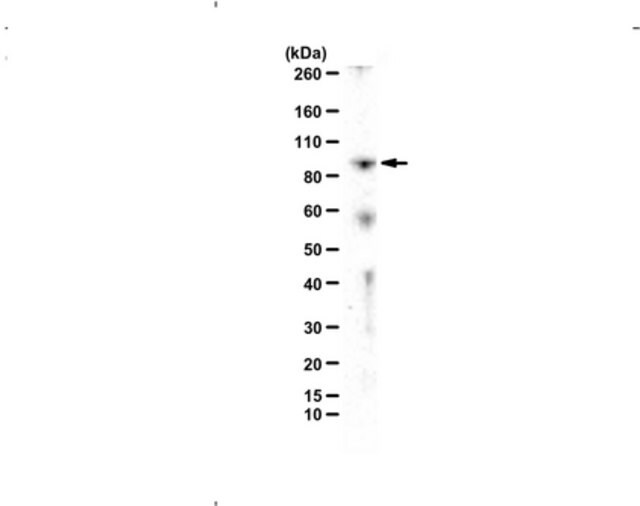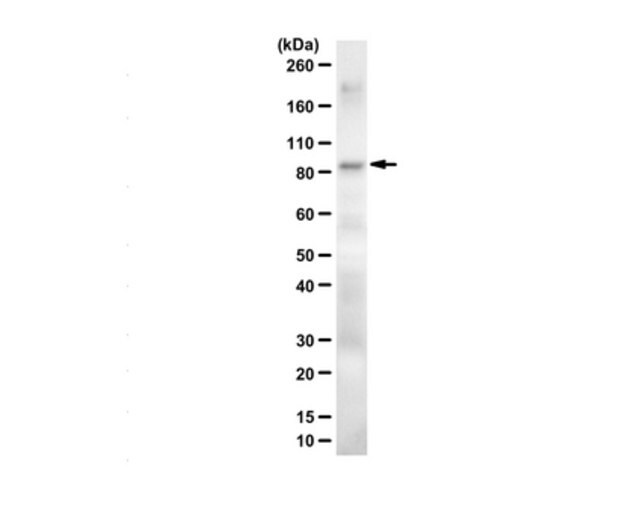您的位置:首页 > 产品中心 > Anti-TDRD3
产品别名
Anti-TDRD3
Tudor domain-containing protein 3
基本信息
| eCl@ss | 32160702 |
| General description【一般描述】 | Tudor domain-containing protein 3 (UniProt: Q9H7E2; also known as TDRD3) is encoded by the TDRD3 gene (Gene ID: 81550) in human. TDRD3 belongs to an evolutionarily conserved family of 12 proteins (TDRD1-TDRD12) that contain one or more Tudor domains, which recognize symmetric dimethylarginine (sDMA) residues with the exception of TDRD3, which associates selectively with asymmetric dimethylarginine. TDRD3, in addition to its Tudor domain, contains a putative nucleic acid recognition motif and an ubiquitin-associated domain. Tudor domains are highly conserved throughout evolution: they can be found in virtually all organisms, from bacteria to mammals. TDRD3 has been reported in heart, brain, placenta, lung, liver, skeletal muscle, kidney, and pancreas. It is found both in the nucleus and in cytoplasm. In nucleus, it acts as a coactivator and recognizes and binds asymmetric dimethylation on the core histone tails. The Tudor domain specifically recognizes and binds asymmetric dimethylation of histone H3 ′Arg-17′ (H3R17me2a) and histones H4 ′Arg-3′, 2 tags for epigenetic transcriptional activation. In cytoplasm, it may play a role in the assembly and/or disassembly of mRNA stress granules and in the regulation of translation of target mRNAs by binding Arg/Gly-rich motifs (GAR) in dimethylarginine-containing proteins. TDRD3 is reported to act as a positive regulator of c-MYC gene transcription by recruiting topoisomerase IIIB (TOP3B) to the c-MYC gene promoter region via H4R3me2a recognition. Overexpression of TDRD3 gene has a strong predictive value for poor prognosis of estrogen receptor-negative breast cancers. (Ref.: Goulet, I et al. (2008). Hum. Mol. Genet. 17(19):3055-3074; Sikorsky, T et al. (2012). Nucleic Acids Res. 40(22):11748-55). |
| Specificity【特异性】 | This polyclonal antibody detects the Tudor domain containing protein 3 in human. It targets an epitope within 258 amino acids in the C-terminal half. |
| Immunogen【免疫原】 | GST-tagged recombinant fragment corresponding to 258 amino acids from the C-terminal half of human Tudor domain-containing protein 3. Epitope: domain of: |
| Application【应用】 | Anti-TDRD3, Cat. No. ABE1868, is a highly specific rabbit polyclonal antibody that targets Tudor domain-containing protein 3 and has been tested in Chromatin Immunoprecipitation (ChIP), Immunoprecipitation, and Western Blotting. Research Category Epigenetics & Nuclear Function Western Blotting Analysis: A 1:500 dilution from a representative lot detected TDRD3 in 20 µL of MCF7 cell lysate. Immunoprecipitation Analysis: A representative lot detected TDRD3 in Immunoprecipitation applications (Yang, Y., et. al. (2014). Mol Cell. 53(3):484-97). Chromatin Immunoprecipitation (ChIP) Analysis: A representative lot detected TDRD3 in Chromatin Immunoprecipitation applications (Yang, Y., et. al. (2014). Mol Cell. 53(3):484-97;Yang, Y., et. al. (2010). Mol Cell. 40(6):1016-23). |
| Quality【质量】 | Evaluated by Immunoprecipitation in MCF7 cell lysate. Immunoprecipitation Analysis: 10 µg of this antibody immunoprecipitated TDRD3 in 500 µg of MCF7 cell lysate. |
| Physical form【外形】 | Format: Unpurified Unpurified Rabbit polyclonal antiserum with 0.05% sodium azide. |
| Other Notes【其他说明】 | Concentration: Please refer to lot specific datasheet. |
产品性质
| biological source【生物来源】 | rabbit |
| Quality Level【质量水平】 | 100 |
| antibody form【抗体形式】 | unpurified |
| antibody product type | primary antibodies |
| clone【克隆】 | polyclonal |
| species reactivity | human |
| technique(s) | ChIP: suitable immunoprecipitation (IP): suitable western blot: suitable |
| isotype【同位素/亚型】 | IgG |
| NCBI accession no.【NCBI登记号】 | NP_110421 |
| UniProt accession no.【UniProt登记号】 | Q9H7E2 |
| shipped in【运输】 | ambient |
产品说明
| Target description【目标描述】 | ~85 kDa observed; 73.18 kDa calculated. Uncharacterized bands may be observed in some lysate(s). |
| Storage and Stability【储存及稳定性】 | Stable for 1 year at -20°C from date of receipt. Handling Recommendations: Upon receipt and prior to removing the cap, centrifuge the vial and gently mix the solution. Aliquot into microcentrifuge tubes and store at -20°C. Avoid repeated freeze/thaw cycles, which may damage IgG and affect product performance. |
| Disclaimer【免责声明】 | Unless otherwise stated in our catalog or other company documentation accompanying the product(s), our products are intended for research use only and are not to be used for any other purpose, which includes but is not limited to, unauthorized commercial uses, in vitro diagnostic uses, ex vivo or in vivo therapeutic uses or any type of consumption or application to humans or animals. |
安全信息
| Storage Class Code【储存分类代码】 | 12 - Non Combustible Liquids |
| WGK | WGK 1 |






